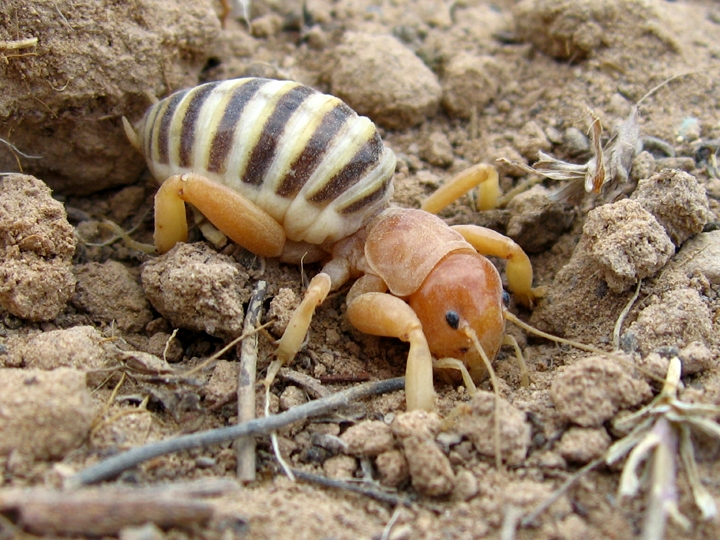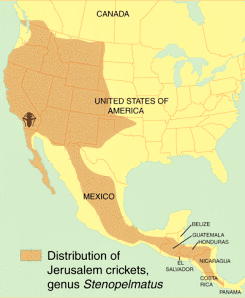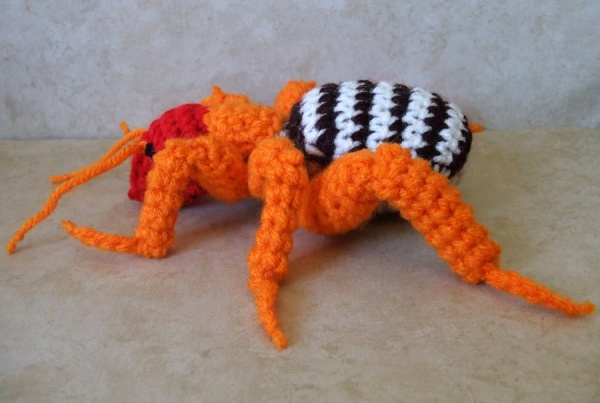Like something from a bad B science fiction movie, the sudden appearance of Jerusalem crickets has caused fear and freaking out among humans who know little about this big-headed, bumbling and lumbering creature. And for good reason: these permanent SoCal residents spend most of their time underground and usually come to the surface when the rains bust up their comfy subterranean condos. Who knew they were there?!
Now that the wet season is upon us, gardeners, hikers and anyone who walks among grassy knolls or sandy dunes may be graced with a sighting of this iconic Southland insect that causes little harm and is considered beneficial in gardens.
Once you get used to its freaky appearance.
“It’s probably the number one call we get from the public,” says Lila Higgins of the Natural History Museum who adds that her top blog post last year was about these charismatic creatures with a round, naked head, two small black eyes and a fat abdomen banded in black and tan. “People find them digging in their gardens and think, “OMG, what IS this crazy bug?”

Higgins says that folks have been fascinated with Jerusalem crickets for centuries and it shows with the copious names it’s been given. Earth Child, Child’s Face (Mexican), Big Red-Skull, Skull Insect (Navajo) and Shiny Bug (Hopis) along with other monikers: Old Bald Man, Jiminy Cricket, Cootie and, the more popular name in California, the Potato Bug (a misnomer because the critter isn’t that fond of potatoes).
The origin of its most common name, Jerusalem cricket, is shrouded in mystery. One theory goes that back in the 19th century, “Jerusalem” was a well-used expletive which you can imagine coming out of the mouth of a starched-collared European seeing the creepy crawly for the first time.

Related to Australian/New Zealand wetas and king crickets of South Africa, not to mention katydids and crickets, this crawler is not just found abundantly in the American Southwest, but Daniel Marlos of the website “What’s that Bug?” says he gets reports of Jerusalem crickets “all over west of the Mississippi and as north as Idaho and Montana. They have quite the range.”

Indeed, for as widespread as they are (in western North and Central America they live on coastlines, in sand dunes and deep in tropical forests), Jerusalem crickets pretty much stay put once they are born.
“There are two categories of Jerusalem crickets that we see in the Southland,” says Douglas Yanega, senior museum scientist in the Department of Entomology at UC Riverside who penned the Wikipedia entry for Jerusalem crickets. One category encompasses the common Jerusalem cricket (probably the ones we see most often) while the other reflects highly specialized species (maybe 50 unique ones) that are restricted to small geographical areas, most notably sand dunes.
“Every isolated sand dune probably has its own species of Jerusalem crickets,” he says explaining that scientists haven’t adequately studied them in-depth and that encroaching development doesn’t bode well for these species. Students looking for research projects, take note.
Since they don’t have wings on their very simplistic large body, Jerusalem crickets don’t roam too far from their birthplace. Yanega says that Jerusalem crickets need that giant head to support its giant mandibles which it uses to gnaw on underground tubers and roots – usually not enough, however to destroy plants. They prefer munching on decaying organic matter and other smaller destructive insects (aphids, beetle larvae, etc.) which should make welcome in any garden.
But…watch out for those big mandibles; a Jerusalem cricket’s bite, while not poisonous, is painful and can draw blood. People often keep them as pets and the internet is full of resources on how to keep a caged Jerusalem cricket happy – best advice: keep them separated; they have been known to eat their own kind.
On the flip side, protein-packed Jerusalem crickets are a dining treat for coyotes, bats, skunks, foxes and owls.
This winter, consider it an omen of good fortune if you encounter a Jerusalem cricket in your SoCal travels. More than likely, the beastie has been flooded out of a home and is currently searching the housing market. We encourage humans to exercise compassion, good sense and take lots of pictures – photos you can later share with friends and family to watch them shriek with fear. Enjoy!
P.S. We are happy to report that crafty-types may be interested in creating a crocheted Jerusalem cricket.

— Brenda Rees, Editor
